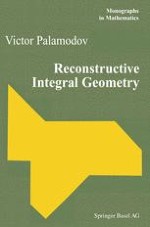2004 | OriginalPaper | Buchkapitel
Reconstruction from Line Integrals
verfasst von : Victor Palamodov
Erschienen in: Reconstructive Integral Geometry
Verlag: Birkhäuser Basel
Enthalten in: Professional Book Archive
Aktivieren Sie unsere intelligente Suche, um passende Fachinhalte oder Patente zu finden.
Wählen Sie Textabschnitte aus um mit Künstlicher Intelligenz passenden Patente zu finden. powered by
Markieren Sie Textabschnitte, um KI-gestützt weitere passende Inhalte zu finden. powered by
Let E be a Euclidean space of dimension n and f be a function in E that decreases at infinity in such a way that any line integral of f converges absolutely. It is sufficient to assume that $$f\left( x \right)\, = O\,\left( {{{\left| x \right|}^{ - 1 - \varepsilon }}} \right)$$ at infinity for some $$\varepsilon \, > \,0.\,$$ We denote by g the line integral of f: 4.1$$g\left( {x,\theta } \right)\, = \,\int_{L\left( {x,\theta } \right)} {fd} s,$$ where L (x, θ) denotes the straight line (or the ray) through the point x ∈ E that is parallel to the unit vector θ. In the case n = 2, data of the line integrals defines the Radon transform of f as follows: R f (p, ω) = g (x, θ) where θ is orthogonal to the unit vector ω and x is any point such that $$\left\langle {\omega,x} \right\rangle \, = \,p.$$ In the case n > 2, the manifold Al (E) of all straight lines has dimension 2n - 2 which implies that data of all line integrals are redundant. To avoid redundancy we state the reconstruction problem as follows:
